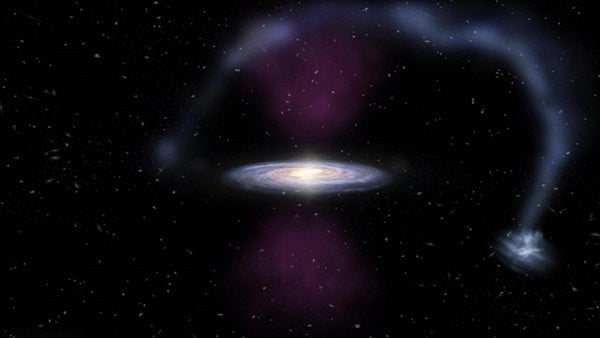Our own Milky Way seems to have a relatively calm center, but astronomers suspect this wasn’t always the case.
The team also estimated when this event occurred. Their data put the outburst at 3.5 million years ago, give or take a million years. That would mean that the Milky Way’s center transitioned from an active to a quiet phase pretty recently in Earth’s history, possibly when early human ancestors were roaming the planet.
The flare would have been visible to the naked eye, shining about 10 times fainter than the Full Moon across a broad spectrum of light wavelengths.
“It would look like the cone of light from a movie projector as it passes through a smoky theater,” University of Sydney astrophysicist and lead study author Jonathan Bland-Hawthorn said in an email.
The researchers describe their findings in an upcoming paper in The Astrophysical Journal.
Following the Trail
Clues to the Milky Way’s active history include giant bubbles of gas ballooning out from the disk of the galaxy. The bubbles, which emit high-energy X-ray and gamma-ray radiation, could have formed when jets of matter shot out from the galaxy’s center.
This new piece of evidence comes from examining a stream of gas that arcs around the Milky Way. This stream of gas is like a trail that two dwarf galaxies, the Large and Small Magellanic Clouds, leave as they orbit the Milky Way. The research team studied ultraviolet (UV) light coming from this gas trail, called the Magellanic Stream.
The characteristics of the UV light indicate that gases in some sections of the stream are in an excited state. Only a very energetic event, like a beam of radiation from an active galactic nucleus, could have done this, according to Bland-Hawthorn. This means that our own home galaxy had an active galactic nucleus phase in the past.
“I think AGN flickering is what goes on for all of cosmic time,” Bland-Hawthorn said. “All galaxies are doing this,” he said, like volcanoes that can lie quietly for long stretches of time but suddenly erupt.
Learning more about the central black hole of our galaxy is an exciting area of research, he added.
“I think Sgr A* is the future of astrophysics, like searching for life signatures around planets,” Bland-Hawthorn said. “I am excited by what we will learn over the next 50 years.”











